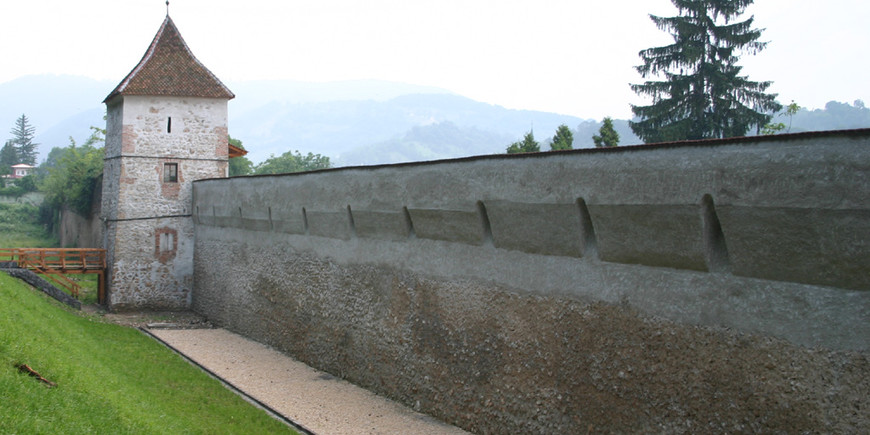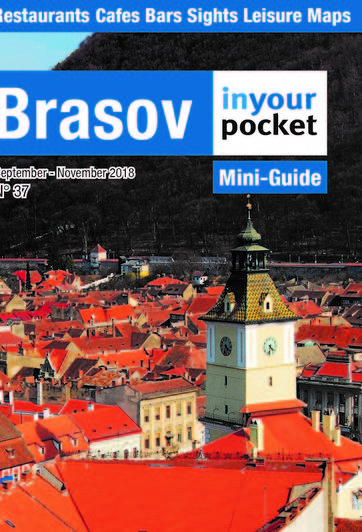City Walls

Northern Walls
The best place to start a tour of fortifications is on the northern side, at Strada Dupa Ziduri (which translates as Street Behind the Walls). You will find it just north of the Livada Postei bus stop, to the right (face on) of the taxi rank. The street starts out inauspiciously - as a car park - but soon gives way to a relatively nice walk alongside the old, high city walls. You will pass under the Bastionul Graft, a wonderfully well-preserved early 16th century relic. Above it is the White Tower (Turnul Alb), which you can climb up to via some very steep steps – do not try it unless you are feeling extremely fit and agile. There are more steps when you actually get to the tower, but the views from the top are fantastic.
Follow the path between the wall and the canal (yes, it is a canal) a little further and you will see an old blue sign pointing the way to the Black Tower (Turnul Negru). You will notice immediately that the tower (which you can see by glancing up to your right) is in fact white. A steep path (but no steps!) leads up to it. The deck in front of it is a great location for photos.
Follow the walls as they veer to the left, and look out for the almost fairy-tale Catherine’s Gate (Poarta Ecaterina), built in 1559 and once the main entrance to medieval Kronstadt. It is the only original city gate to have survived. A little further on is the classicist Poarta Schei gate, which was built much later, in 1827.
Passing by an athletics stadium (which is part of Brasov’s exceptional sports high school), the vaguely gothic-looking building which rears up, overlooking the tennis courts, is known as the Olimpia complex, originally built almost entirely of wood in 1894. It has been recently renovated and is home to a restaurant with terrace, as well as the Olimpia Tennis Club.
Southern Walls
The walls along the foot of the Tampa Mountain were once 12 metres high and two metres thick. Over the past few years almost all of the wall on this side - along Aleea Tiberiu Bradiceanu - has been rebuilt, and wooden walkways placed on top so that you can climb up and take some terrific photos of the city. Where there are no walkways you can stroll along the quiet path next to the wall.
A number of the original guard towers on this side of Brasov's fortifications have survived remarkably well, and the first you will come to is the imposing Weavers' Bastion next to the Olimpia building. The best preserved part of Brasov's fortifications, the bastion (Bastionul Tesatorilor) houses a small but impressive museum (with some English captions) showing photographs of long-gone bastions, impressive weapons decorated with Arabic inscriptions (once used by the Turks to bash Saxons) and some huge guns. Most impressive of all is the large model of Brasov in 1600, made in 1896 for the Millennium Exhibition in Budapest (in those days Brasso was part of Hungary). When Nicolae Ceausescu visited the museum in 1968, a bright and shiny model of the Schei district was added to the old, depicting Schei circa 1850.
There are five more towers and bastions on this side of the wall, known as, in order, Turnul Artelor, Turnul Funarilor, Turnul Vanatorilor, Turnul Lemnarului and Bastionul Postavarilor.
All have been restored and three (Turnul Artelor, Turnul Vanatorilor and Bastionul Postavarilor) are open to the public, usually from 09:00-18:00. Entrance to all is free.
While the Bastionul Postavarilor is the most impressive (outside and in), it is the upper floors (mind the steep ladders) of the Turnul Vanatorilor that offers the best views of the city.
The cable car up to the top of the Tampa is found a short walk uphill from the Turnul Vanatorilor; next to it is the Casa Padurarilor restaurant. A number of walking routes up the Tampa also begin here. The newest construction is the area is the Tampa complex, which has a great terrace and an indoor swimming pool, which really does offer a swim with a view.





Comments